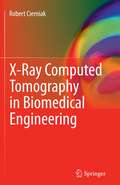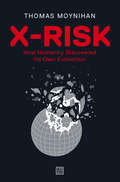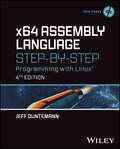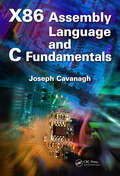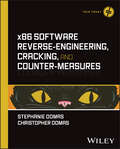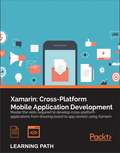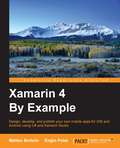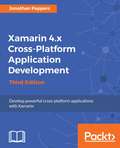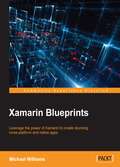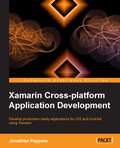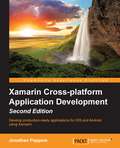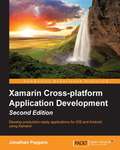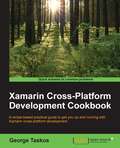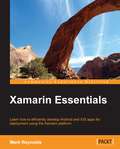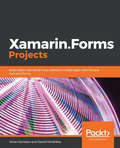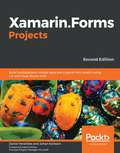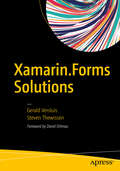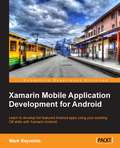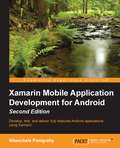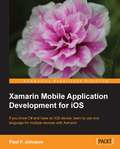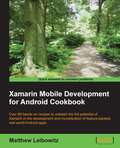- Table View
- List View
X-Machines for Agent-Based Modeling: FLAME Perspectives (Chapman & Hall/CRC Computer and Information Science Series)
by Mariam KiranFrom the Foreword: "This book exemplifies one of the most successful approaches to modeling and simulating [the] new generation of complex systems. FLAME was designed to make the building of large scale complex systems models straightforward and the simulation code that it generates is highly efficient and can be run on any modern technology. FLAME was the first such platform that ran efficiently on high performance parallel computers and a version for GPU technology is also available. At its heart, and the reason why it is so efficient and robust, is the use of a powerful computational model ‘Communicating X-machines’ which is general enough to cope with most types of modelling problems. As well as being increasingly important in academic research, FLAME is now being applied in industry in many different application areas. This book describes the basics of FLAME and is illustrated with numerous examples."—Professor Mike Holcombe, University of Sheffield, UK Agent-based models have shown applications in various fields such as biology, economics, and social science. Over the years, multiple agent-based modeling frameworks have been produced, allowing experts with non-computing background to easily write and simulate their models. However, most of these models are limited by the capability of the framework, the time it takes for a simulation to finish, or how to handle the massive amounts of data produced. FLAME (Flexible Large-scale Agent-based Modeling Environment) was produced and developed through the years to address these issues. This book contains a comprehensive summary of the field, covers the basics of FLAME, and shows how concepts of X-machines, can be stretched across multiple fields to produce agent models. It has been written with several audiences in mind. First, it is organized as a collection of models, with detailed descriptions of how models can be designed, especially for beginners. A number of theoretical aspects of software engineering and how they relate to agent-based models are discussed for students interested in software engineering and parallel computing. Finally, it is intended as a guide to developers from biology, economics, and social science, who want to explore how to write agent-based models for their research area. By working through the model examples provided, anyone should be able to design and build agent-based models and deploy them. With FLAME, they can easily increase the agent number and run models on parallel computers, in order to save on simulation complexity and waiting time for results. Because the field is so large and active, the book does not aim to cover all aspects of agent-based modeling and its research challenges. The models are presented to show researchers how they can build complex agent functions for their models. The book demonstrates the advantage of using agent-based models in simulation experiments, providing a case to move away from differential equations and build more reliable, close to real, models. The Open Access version of this book, available at https://doi.org/10.1201/9781315370729, has been made available under a Creative Commons Attribution-Non Commercial-No Derivatives 4.0 license.
X Power Tools
by Chris TylerThis book puts you in charge of the most flexible and adaptable graphical interface in the computer industry. The X Window System underlies graphical desktops on Linux and Unix systems, and supports advanced features of modern graphics cards. More people use the X Window System than ever before, but there are few books about X in print. X Power Tools fills that hole with the most practical and up-to-date information available. Written in O'Reilly's popular Power Tools format, X Power Tools offers dozens of standalone articles, thoroughly cross-referenced, on useful tools and techniques for using X. This unique inside look at X gives Unix/Linux system administrators, owners of self-administered systems, and power users a lot of useful ways to harness the power of this system effectively. This book:Offers a thorough grounding in X configuration and how the system works Provides the complete ins and outs of changing a desktop's behavior, such as fonts, keyboard settings, and remote security Includes articles on how to take advantage of X's "network transparency" -- its ability to display graphical applications on a remote machine Explores intriguing areas such as using multiple monitors, building kiosks, and accessibility Features discussions on X Window innovations and the future of the system X Power Tools covers configuration and use of X, focusing on Linux but also including notes on other operating systems such as Solaris and FreeBSD. Each article in the book gives you insight into X; the entire book gives you a real grasp on this system and what you can do with it.
X-Ray Computed Tomography in Biomedical Engineering
by Robert CierniakComputed Tomography gives a detailed overview of various aspects of computed tomography. It discusses X-ray CT tomography from a historical point of view, the design and physical operating principles of computed tomography apparatus, the algorithms of image reconstruction and the quality assessment criteria of tomography scanners. Algorithms of image reconstruction from projections, a crucial problem in medical imaging, are considered in depth. The author gives descriptions of the reconstruction methods related to tomography scanners with a parallel X-ray beam, trough solutions with fan-shaped beam and successive modifications of spiral scanners. Computed Tomography contains a dedicated chapter for those readers who are interested in computer simulations based on studies of reconstruction algorithms. The information included in this chapter will enable readers to create a simulation environment in which virtual tomography projections can be obtained in all basic projection systems. This monograph is a valuable study on computed tomography that will be of interest to advanced students and researchers in the fields of biomedical engineering, medical electronics, computer science and medicine.
X-ray Imaging of the Soil Porous Architecture
by Sacha Jon Mooney Iain M. Young Richard J. Heck Stephan PethThe advent of X-ray Computed Tomography (CT) as a tool for the soil sciences almost 40 years ago has revolutionised the field. Soil is the fragile, thin layer of material that exists above earth’s geological substrates upon which so much of life on earth depends. However a major limitation to our understanding of how soils behave and function is due to its complex, opaque structure that hinders our ability to assess its porous architecture without disturbance. X-ray imagery has facilitated the ability to truly observe soil as it exists in three dimensions and across contrasting spatial and temporal scales in the field in an undisturbed fashion. This book gives a comprehensive overview of the “state of the art” in a variety of application areas where this type of imaging is used, including soil water physics and hydrology, agronomic management of soils, and soil-plant-microbe interactions. It provides the necessary details for entry level readers in the crucial areas of sample preparation, scanner optimisation and image processing and analysis. Drawing on experts across the globe, from both academia and industry, the book covers the necessary “dos and don’ts”, but also offers insights into the future of both technology and science. The wider application of the book is provided by dedicated chapters on how the data from such imagery can be incorporated into models and how the technology can be interfaced with other relevant technical applications. The book ends with a future outlook from the four editors, each of whom has over 20 years of experience in the application of X-ray CT to soil science.
X-Risk: How Humanity Discovered Its Own Extinction
by Thomas MoynihanHow humanity came to contemplate its possible extinction.From forecasts of disastrous climate change to prophecies of evil AI superintelligences and the impending perils of genome editing, our species is increasingly concerned with the prospects of its own extinction. With humanity's future on this planet seeming more insecure by the day, in the twenty-first century, existential risk has become the object of a growing field of serious scientific inquiry. But, as Thomas Moynihan shows in X-Risk, this preoccupation is not exclusive to the post-atomic age of global warming and synthetic biology. Our growing concern with human extinction itself has a history. Tracing this untold story, Moynihan revisits the pioneers who first contemplated the possibility of human extinction and stages the historical drama of this momentous discovery. He shows how, far from being a secular reprise of religious prophecies of apocalypse, existential risk is a thoroughly modern idea, made possible by the burgeoning sciences and philosophical tumult of the Enlightenment era. In recollecting how we first came to care for our extinction, Moynihan reveals how today's attempts to measure and mitigate existential threats are the continuation of a project initiated over two centuries ago, which concerns the very vocation of the human as a rational, responsible, and future-oriented being.
x64 Assembly Language Step-by-Step: Programming with Linux (Tech Today)
by Jeff DuntemannThe long-awaited x64 edition of the bestselling introduction to Intel assembly language In the newly revised fourth edition of x64 Assembly Language Step-by-Step: Programming with Linux, author Jeff Duntemann delivers an extensively rewritten introduction to assembly language with a strong focus on 64-bit long-mode Linux assembler. The book offers a lighthearted, robust, and accessible approach to a challenging technical discipline, giving you a step-by-step path to learning assembly code that’s engaging and easy to read. x64 Assembly Language Step-by-Step makes quick work of programmable computing basics, the concepts of binary and hexadecimal number systems, the Intel x86/x64 computer architecture, and the process of Linux software development to dive deep into the x64 instruction set, memory addressing, procedures, macros, and interface to the C-language code libraries on which Linux is built. You’ll also find: A set of free and open-source development and debugging tools you can download and put to use immediately Numerous examples woven throughout the book to illustrate the practical implementation of the ideas discussed within Practical tips on software design, coding, testing, and debuggingA one-stop resource for aspiring and practicing Intel assembly programmers, the latest edition of this celebrated text provides readers with an authoritative tutorial approach to x64 technology that’s ideal for self-paced instruction.
X86 Assembly Language and C Fundamentals
by Joseph CavanaghThe predominant language used in embedded microprocessors, assembly language lets you write programs that are typically faster and more compact than programs written in a high-level language and provide greater control over the program applications. Focusing on the languages used in X86 microprocessors, X86 Assembly Language and C Fundamentals expl
x86 Software Reverse-Engineering, Cracking, and Counter-Measures (Tech Today)
by Stephanie Domas Christopher DomasA crystal-clear and practical blueprint to software disassembly x86 Software Reverse-Engineering, Cracking, and Counter-Measures is centered around the world of disassembling software. It will start with the basics of the x86 assembly language, and progress to how that knowledge empowers you to reverse-engineer and circumvent software protections. No knowledge of assembly, reverse engineering, or software cracking is required. The book begins with a bootcamp on x86, learning how to read, write, and build in the assembly that powers a massive amount of the world’s computers. Then the book will shift to reverse engineering applications using a handful of industry favorites such as IDA, Ghidra, Olly, and more. Next, we move to cracking with techniques such as patching and key generation, all harnessing the power of assembly and reverse engineering. Lastly, we’ll examine cracking from a defensive perspective. Providing learners with techniques to be a better defender of their own software, or knowledge to crack these techniques more effectively. Assembly: computer Architecture, x86, system calls, building and linking, ASCII, condition codes, GDB, control flow, stack, calling conventions Reverse Engineering: reconnaissance, strings, RE strategy, stripping, linking, optimizations, compilers, industry tools Cracking: patching, key checkers, key generators, resource hacking, dependency walking Defense: anti-debugging, anti-tamper, packing, cryptors/decryptors, whitelist, blacklist, RASP, code signing, obfuscationA practical and hands-on resource for security professionals to hobbyists, this book is for anyone who wants to learn to take apart, understand, and modify black-box software. x86 Software Reverse-Engineering, Cracking, and Counter-Measures is a vital resource for security researchers, reverse engineers and defenders who analyze, research, crack or defend software applications.
Xamarin: Cross-Platform Mobile Application Development
by George Taskos Can Bilgin Jonathan PeppersMaster the skills required to develop cross-platform applications from drawing board to app store(s) using Xamarin About This Book * Learn to deliver high-performance native apps that leverage platform specific acceleration, complied for native performance * Learn development techniques that will allow you to use and create custom layouts for cross-platform UI * Gain the knowledge needed to become more efficient in testing, deploying, and monitoring your applications * Implement application life cycle management concepts to manage cross-platform projects Who This Book Is For Mobile application developers wanting to develop skills required to steer cross-platform applications using Xamarin. What You Will Learn * Share C# code across platforms and call native Objective-C or Java libraries from C# * Submit your app to the Apple App Store and Google Play * Use the out-of-the-box services to support third-party libraries * Find out how to get feedback while your application is used by your users * Create shared data access using a local SQLite database and a REST service * Test and monitor your applications * Gain memory management skills to avoid memory leaks and premature code cycles while decreasing the memory print of your applications * Integrate network resources with cross-platform applications * Design and implement eye-catching and reusable UI components without compromising on nativity in mobile applications In Detail Developing a mobile application for just one platform is becoming a thing of the past. Companies expect their apps to be supported on iOS, Android and Windows Phone, while leveraging the best native features on all three platforms. Xamarin's tools help ease this problem by giving developers a single toolset to target all three platforms. The main goal of this course is to equip you with knowledge to successfully analyze, develop, and manage Xamarin cross-platform projects using the most efficient, robust, and scalable implementation patterns. Module 1 is a step-by-step guide to building real-world applications for iOS and Android. The module walks you through building a chat application, complete with a backend web service and native features such as GPS location, camera, and push notifications. Additionally, you'll learn how to use external libraries with Xamarin and Xamarin.Forms. Module 2 provide you recipes on how to create an architecture that will be maintainable, extendable, use Xamarin.Forms plugins to boost productivity. We start with a simple creation of a Xamarin.Forms solution, customize the style and behavior of views for each platform. Further on, we demonstrate the power of architecting a cross-platform solution. Next, you will utilize and access hardware features that vary from platform to platform with cross-platform techniques. You will master the steps of getting the app ready and publishing it in the app store. The last module starts with general topics such as memory management, asynchronous programming, local storage, networking, and platform-specific features. You will learn about key tools to leverage the pattern and advanced implementation strategies. Finally, we show you the toolset for application lifecycle management to help you prepare the development pipeline to manage and see cross-platform projects through to public or private release. After the completion of this course, you will learn a path that will get you up and running with developing cross-platform mobile applications and help you become the go-to person when it comes to Xamarin. Style and approach This course will serve as comprehensive guide for developing cross-platform applications with Xamarin with a unique approach that will engage you like never before as you create real-world cross-platform apps on your own.
Xamarin 4 By Example
by Matteo Bortolu Engin PolatDesign, develop, and publish your own mobile apps for iOS and Android using C# and Xamarin Studio About This Book * Explore the exciting features of Xamarin Studio while learning to develop your own applications * Develop a complete application from conceptualization through to publishing it on the app store * The book walks you through the basics of cross-platform development with Xamarin using examples and best practices and tips for cross platform solutions. Who This Book Is For If you want to develop your own applications and want to explore the features of Xamarin Studio, then this is the book for you. It is expected that you have a basic understanding of technologies in mobile development, but prior knowledge of Xamarin is not required. What You Will Learn * Understand the software development lifecycle for mobile applications * Use Xamarin Studio and its wide range of features to write your programs in C# * Use different options to create multi-platform applications using Xamarin and develop a cross-platform extension method * Work with Xamarin forms and various UI controls * Integrate synchronous and asynchronous communication module within your app * Render images to work with Android and iOS * Link a third-party application to your solution In Detail The mobile app market is increasing exponentially every year. Xamarin Studio with its modern and powerful IDEs makes creating applications a lot easier by simplifying the development process. Xamarin will allow you and your team to create native applications by taking advantage of one of the most evolved programming language in the world: C#. This book will provide you with the basic skills you need to start developing mobile apps using C# and Xamarin. By working through the examples in each chapter, you will gain hands-on experience of creating a complete app that is fully functional by all means. Finally, you will learn to publish the app you created on the app market. Each project in this book will take you one step closer to becoming a professional app developer. Style and approach The step-by-guide will walk you through the process of creating an application of with the help of small projects that will teach you everything you need to know to build a complete application of your own.
Xamarin 4.x Cross-Platform Application Development - Third Edition
by Jonathan PeppersDevelop powerful cross-platform applications with Xamarin About This Book • Write native cross-platform applications with Xamarin • Design user interfaces that can be shared across Android, iOS, and Windows Phone using Xamarin.Forms • Practical cross-platform development strategies Who This Book Is For If you are a developer with experience in C# and are just getting into mobile development, this is the book for you. This book will give you a head start with cross-platform development and will be the most useful to developers who have experience with desktop applications or the web. What You Will Learn • Apple's MVC design pattern • The Android activity lifecycle • Share C# code across platforms and call native Objective-C or Java libraries from C# • Create a real web service back end in Windows Azure using SQL Azure as database storage • Set up third-party libraries such as NuGet and Objective Sharpie in many different ways, and port a desktop .NET library to Xamarin • Use Xamarin.Mobile for camera, contacts, and location In Detail Xamarin is a leading cross-platform application development tool used by top companies such as Coca-Cola, Honeywell, and Alaska Airlines to build apps. Version 4 features significant updates to the platform including the release of Xamarin.Forms 2.0 and improvements have been made to the iOS and Android designers. Xamarin was acquired by Microsoft so it is now a part of the Visual Studio family. This book will show you how to build applications for iOS, Android, and Windows. You will be walked through the process of creating an application that comes complete with a back-end web service and native features such as GPS location, camera, push notifications, and other core features. Additionally, you'll learn how to use external libraries with Xamarin and Xamarin.Forms to create user interfaces. This book also provides instructions for Visual Studio and Windows. This edition has been updated with new screenshots and detailed steps to provide you with a holistic overview of the new features in Xamarin 4. Style and approach This book offers a tutorial style approach to teach you the skills required to develop end-to-end cross-platform solutions with Xamarin.
Xamarin Blueprints
by Michael WilliamsLeverage the power of Xamarin to create stunning cross-platform and native apps About This Book * Helps you get a clear practical understanding of creating professional-grade apps with Xamarin * Covers Xamarin.Forms, Xamarin Android, and Xamarin iOS * If you want to transform yourself from an amateur mobile developer into a professional app developer across multiple platforms, then this is the ideal book for you Who This Book Is For If you are a mobile developer looking to create interesting and fully featured apps for different platforms, then this book is the ideal solution for you. A basic knowledge of Xamarin and C# programming is assumed What You Will Learn * Discover eight different ways to create your own Xamarin applications * Improve app performance by using SQLite for data-intensive applications * Set up a simple web service to feed JSON data into mobile applications * Store files locally with Xamarin.Forms using dependency services * Use Xamarin extension libraries to create effective applications with less coding In Detail Do you want to create powerful, efficient, and independent apps from scratch that will leverage the Xamarin framework and code with C#? Well, look no further; you've come to the right place! This is a learn-as-you-build practical guide to building eight full-fledged applications using Xamarin.Forms, Xamarin Android, and Xamarin iOS. Each chapter includes a project, takes you through the process of building applications (such as a gallery Application, a text-to-speech service app, a GPS locator app, and a stock market app), and will show you how to deploy the application's source code to a Google Cloud Source Repository. Other practical projects include a chat and a media-editing app, as well as other examples fit to adorn any developer's utility belt. In the course of building applications, this book will teach you how to design and prototype professional-grade applications implementing performance and security considerations. Style and approach A project-based approach that will solve all your needs when it comes to creating native Android, iOS, and cross-platform apps efficiently and effectively.
Xamarin Cross-platform Application Development
by Jonathan Peppers"Xamarin Cross-platform Application Development" is an end-to-end walk-through tutorial on developing applications for both iOS and Android. It offers clear and detailed explanations of each stage in the process, making it easier for you to master the creation of stable, production-ready, cross-platform apps. This book is for C# developers who are interested in mobile application development. If you have experience with desktop or web applications, this book will serve as a great tool to give you a head start with cross-platform development.
Xamarin Cross-platform Application Development - Second Edition
by Jonathan PeppersIf you are a developer with experience in C# and are just getting into mobile development, this is the book for you. If you have experience with desktop applications or the Web, this book will give you a head start on cross-platform development.
Xamarin Cross-platform Application Development Second Edition
by Jonathan PeppersIf you are a developer with experience in C# and are just getting into mobile development, this is the book for you. If you have experience with desktop applications or the Web, this book will give you a head start on cross-platform development.
Xamarin Cross-Platform Development Cookbook
by George TaskosA recipe-based practical guide to get you up and running with Xamarin cross-platform development About This Book * Gain the skills and expertise to create, test, and deploy native mobile applications in the three major mobile app stores that share up to 95% of the same code * Learn development techniques that will allow you to use and create custom layouts for each platform, cross-platform UI * Gain the knowledge needed to become more efficient in testing, deploying, and monitoring your applications, helping you through all stages of the software development life cycle Who This Book Is For This book is for mobile developers. You must have some basic experience of C# programming, but no previous experience with Xamarin is required. If you are just starting with C# and want to use Xamarin todevelop cross-platform apps effectively and efficiently, then this book is the right choice for you. What You Will Learn * Create and customize your cross-platform UI * Understand and explore cross-platform patterns and practices * Use the out-of-the-box services to support third-party libraries * Find out how to get feedback while your application is used by your users * Bind collections to ListView and customize its appearance with custom cells * Create shared data access using a local SQLite database and a REST service * Test and monitor your applications In Detail You can create native mobile applications using the Xamarin Forms platform for the three major platforms iOS, Android, and Windows Phone. The advantage of this is sharing as much code as you can, such as the UI, business logic, data models, SQLite data access, HTTP data access, and file storage across the three major platforms. This book provide recipes on how to create an architecture that will be maintainable, extendable, use Xamarin Forms plugins to boost productivity, customize your views per platforms, and use platform-specific implementations at runtime. We start with a simple creation of a Xamarin Forms solution with the three major platforms. We will then jump to XAML recipes and you will learn how to create a tabbed application page, and customize the style and behavior of views for each platform. Moving on, you will acquire more advanced knowledge and techniques while implementing views and pages for each platform and also calling native UI screens such as the native camera page. Further on, we demonstrate the power of architecting a cross-platform solution and how to share code between platforms, create abstractions, and inject platform-specific implementations. Next, you will utilize and access hardware features that vary from platform to platform with cross-platform techniques. We'll then show you the power of databinding offered by Xamarin Forms and how you can create bindable models and use them in XAML. You will learn how to handle user interactions with the device and take actions in particular events. With all the work done and your application ready, you will master the steps of getting the app ready and publishing it in the app store. Style and approach This book will serve as a quick reference with a unique recipe-based approach that will engage you like never before as you create real-world cross-platform apps on your own.
Xamarin Essentials
by Mark ReynoldsIf you are an experienced iOS and Android developer and have a desire to learn about the Xamarin platform, then you will find this tutorial to be the most efficient, interesting, and relevant path. You will find this guide to be especially useful if you wish to become proficient in creating apps using the Xamarin platform, as Xamarin Essentials teaches you the fundamentals of iOS and Android development.
Xamarin.Forms Projects: Build Seven Real-world Cross-platform Mobile Apps With C# And Xamarin. Forms
by Johan Karlsson Daniel HindrikesThe book is for mobile application developers who want to start building native mobile apps and use the knowledge that they already have. Working knowledge of C#, .NET and Visual Studio is required.
Xamarin.Forms Projects: Build multiplatform mobile apps and a game from scratch using C# and Visual Studio 2019, 2nd Edition
by Johan Karlsson Daniel Hindrikes David OrtinauLearn to build cross-platform mobile apps using the latest features in Xamarin.Forms 4 with the help of a series of projects including apps for real-time chatting, AR games, location-tracking, weather, photo galleries, and much more Key Features Develop mobile apps, AR games, and chatbots of varying complexity with the help of real-world examples Explore the important features of Xamarin.Forms 4 such as Shell, CollectionView, and CarouselView Get to grips with advanced concepts such as AR and VR and machine learning for mobile development Book Description Xamarin.Forms is a lightweight cross-platform development toolkit for building apps with a rich user interface. Improved and updated to cover the latest features of Xamarin.Forms, this second edition covers CollectionView and Shell, along with interesting concepts such as augmented reality (AR) and machine learning. Starting with an introduction to Xamarin and how it works, this book shares tips for choosing the type of development environment you should strive for when planning cross-platform mobile apps. You'll build your first Xamarin.Forms app and learn how to use Shell to implement the app architecture. The book gradually increases the level of complexity of the projects, guiding you through creating apps ranging from a location tracker and weather map to an AR game and face recognition. As you advance, the book will take you through modern mobile development frameworks such as SQLite, .NET Core Mono, ARKit, and ARCore. You'll be able to customize your apps for both Android and iOS platforms to achieve native-like performance and speed. The book is filled with engaging examples, so you can grasp essential concepts by writing code instead of reading through endless theory. By the end of this book, you'll be ready to develop your own native apps with Xamarin.Forms and its associated technologies, such as .NET Core, Visual Studio 2019, and C#. What you will learn Set up Xamarin.Forms to build native apps with code-sharing capabilities Understand the core aspects of developing a mobile app, such as its layout, UX, and rendering Use custom renderers to gain platform-specific access Discover how to create custom layouts for your apps with Xamarin.Forms Shell Use Azure SignalR to implement serverless services in your Xamarin apps Create an augmented reality (AR) game for Android and iOS using ARCore and ARKit, respectively Build and train machine learning models using CoreML, TensorFlow, and Azure Cognitive Services Who this book is for This book is for C# and .NET developers who want to learn Xamarin.Forms and get started with native Xamarin mobile application development from the ground up. Working knowledge of Visual Studio will help you to get the most out of this book.
Xamarin.Forms Solutions
by Gerald Versluis Steven ThewissenUse the solutions provided in this book to handle common challenges in Xamarin.Forms that are encountered on a daily basis. Working examples and techniques are presented that you can modify and drop directly into your own projects. You will be able to deliver working code faster than ever. Examples are made available through GitHub, maximizing the convenience and value this book provides to Xamarin.Forms developers. Solutions in the book are organized broadly into problem domains such as user interface for applications, data and security, connectivity and external services, and more. Within each domain the book presents specific solutions addressing challenges that are commonly faced. Under data and security, for example, you’ll find specific solutions around storing login credentials, local data caching, and sending authorization tokens in HTTP requests. Not only do the solutions in the book solve specific problems, they also present best practices that can inform and improve the quality of the code that you write. Xamarin.Forms Solutions is chock full of practical advice and code examples that no Xamarin.Forms programmer will want to be without. The basics of Xamarin.Forms are provided for beginning developers.What You'll LearnKnow the in-depth basics of Xamarin.Forms and the inner workingsCreate custom renderers and dependency servicesManage the appearance of user interfaces through styling and theming, layout options, rotation, and animationBuild sophisticated user interfaces using a variety of controls that allow for PDF viewing, barcode interpretation, searching and finding, and other controlsSecure your applications, and communicate securely with services via HTTP requestsSign and deploy your apps and optimize the binary file sizeWho This Book Is ForThose building mobile applications on the Xamarin platform for iOS and Android. By mixing together the solutions and a thorough explanation of the basics of Xamarin.Forms, the book spans the needs of beginning through intermediate Xamarin.Forms developers. Even experts will find a few gems to improve the quality and speed of their application development work.
Xamarin in Action: Creating native cross-platform mobile apps
by Jim BennettSummaryXamarin in Action teaches you to build cross-platform mobile apps using Xamarin and C#. You'll explore all the layers of a Xamarin app, from design to deployment. By the end, you'll be able to build a quality, production-ready Xamarin app on iOS and Android from scratch with a high level of code reuse.Purchase of the print book includes a free eBook in PDF, Kindle, and ePub formats from Manning Publications.About the TechnologyRewriting the same app for iOS and Android is tedious, error-prone, and expensive. Microsoft's Xamarin drastically reduces dev time by reusing most application code—typically 70% or more. The core of your iOS and Android app is shared; you write platform-specific code only for the UI layer. And because Xamarin uses C#, your apps benefit from everything this modern language and the .NET ecosystem have to offer.About the BookXamarin in Action teaches you to build cross-platform mobile apps using Xamarin and C#. You'll explore all the layers of a Xamarin app, from design to deployment. Xamarin expert Jim Bennett teaches you design practices that maximize code reuse and isolate device-specific code, making it a snap to incorporate the unique features of each OS.What's InsideUnderstanding MVVM to maximize code reuse and testabilityCreating cross-platform model and UI logic layersBuilding device-specific UIsUnit and automated UI testingPreparing apps for publication with user tracking and crash analyticsAbout the ReaderReaders should have some experience with C#. Mobile development experience is helpful, but not assumed.About the AuthorJim Bennett is a Xamarin MYP, Microsoft MVP, and Senior Cloud Developer Advocate at Microsoft, specializing in Xamarin mobile apps. He's a frequent speaker at events all around the world, including Xamarin user groups and Xamarin and Microsoft conferences. He regularly blogs about Xamarin development at https://jimbobbennett.io.Table of ContentsPART 1 - GETTING STARTED WITH XAMARIN Introducing native cross-platform applications with Xamarin Hello MVVM—creating a simple cross-platform app using MVVM MVVM—the model-view–view model design pattern Hello again, MVVM—understanding and enhancing our simple MVVM appWhat are we (a)waiting for? An introduction to multithreading for Xamarin apps PART 2 - BUILDING APPSDesigning MVVM cross-platform apps Building cross-platform models Building cross-platform view models Building simple Android views Building more advanced Android views Building simple iOS views Building more advanced iOS views PART 3 - FROM WORKING CODE TO THE STORERunning mobile apps on physical devices Testing mobile apps using Xamarin UITest Using App Center to build, test, and monitor apps Deploying apps to beta testers and the stores
Xamarin Mobile Application Development for Android
by Mark ReynoldsA step-by-step tutorial that follows the development of a simple Android app from end to end, through troubleshooting, and then distribution. The language used assumes a knowledge of basic C#. If you are a C# developer with a desire to develop Android apps and want to enhance your existing skill set, then this book is for you. It is assumed that you have a good working knowledge of C#, .NET, and object-oriented software development. Familiarity with rich client technologies such as WPF or Silverlight is also helpful, but not required.
Xamarin Mobile Application Development for Android - Second Edition
by Nilanchala PanigrahyDevelop, test, and deliver fully-featured Android applications using Xamarin About This Book * Build and test multi-view Android applications using Xamarin.Android * Work with device capabilities such as location sensors and the camera * A progressive, hands-on guide to develop stunning Android applications using Xamarin Who This Book Is For If you are a C# developer who wants to develop Android apps and enhance your existing skill set, then this book is ideal for you. Good working knowledge of C#, .NET, and object-oriented software development is assumed. What You Will Learn * Build a multi-view, orientation-aware Android application with navigation * Lay out content using the LinearLayout, RelativeLayout, and TableLayout layout managers * Use a ListView (AdapterView) and Adapter to build a view that is populated from server data * Consume REST web service to perform GET, UPDATE, DELETE operation * Use Android SQLite for data persistence and caching * Capture the current location of a device, determine the street address, and integrate with the map app * Test, debug, and deploy an Android app In Detail Technology trends come and go, but few have generated the excitement, momentum, or long-term impact that mobile computing has. Mobile computing impacts people's lives at work and at home on a daily basis. Many companies and individual developers are looking to become a part of the movement but are unsure how to best utilize their existing skills and assets. The Xamarin suite of products provides new opportunities to those who already have a significant investment in C# development skills and .NET code bases, and would like to enter into this new, exciting world. This example-oriented guide provides a practical approach to quickly learn the fundamentals of Android app development using C# and Xamarin.Android. It will lead you through building an Android app step-by-step with steadily increasing complexity. Beginning with an overview of the Android and Xamarin platforms to provide you with a solid understanding of the underlying platform, we gradually walk through building and testing a Points of Interest Android app using C# and the Xamarin.Android product. You will learn to create ListView and add detail view to your Android application. You will handle application behaviors on orientation changes, before learning the different techniques to manage resources and layouts to support multiple screen sizes. You will then access a SQLite database in a cross-platform way and add location features to your application. Finally, you will add camera integration to your application and deploy your app to the various Android app stores. Style and approach An example-oriented, comprehensive guide to gain an understanding of both the Android and Xamarin platforms.
Xamarin Mobile Application Development for iOS
by Paul F. JohnsonThis book is a standard tutorial aimed at teaching you everything you need to know about iOS app development using Xamarin.This book is written for those who are new to iOS app development as well as more experienced developers who just need a quick reference book. It is assumed that you are already comfortable using C#. Those teaching iOS to new students will also find this book invaluable as a form of reference material.
Xamarin Mobile Development for Android Cookbook
by Matthew LeibowitzOver 80 hands-on recipes to unleash full potential for Xamarin in development and monetization of feature-packed, real-world Android apps About This Book * Create a number of Android applications using the Xamarin Android platform * Extensively integrate your Android devices with other Android devices to enhance your app creation experience * A comprehensive guide packed with real-world scenarios and pro-level practices and techniques to help you build successful Android apps Who This Book Is For If you are a Xamarin developer who wants to create complete Android applications with Xamarin, then this book is ideal for you. No prior knowledge of Android development is needed, however a basic knowledge of C# and .NET would be useful. What You Will Learn * Install and use Xamarin.Android with Xamarin Studio and Visual Studio * Design an app's user interface for multiple device configurations * Store and protect data in databases, files, and on the cloud * Utilize lists and collections to present data to the user * Communicate across the network using NFC or Bluetooth * Perform tasks in the background and update the user with notifications * Capture and play multimedia, such as video and audio, with the camera * Implement In-App Billing and Expansion Files and deploy to the store In Detail Xamarin is used by developers to write native iOS, Android, and Windows apps with native user interfaces and share code across multiple platforms not just on mobile devices, but on Windows, Mac OS X, and Linux. Developing apps with Xamarin.Android allows you to use and re-use your code and your skills on different platforms, making you more productive in any development. Although it's not a write-once-run-anywhere framework, Xamarin provides native platform integration and optimizations. There is no middleware; Xamarin.Android talks directly to the system, taking your C# and F# code directly to the low levels. This book will provide you with the necessary knowledge and skills to be part of the mobile development era using C#. Covering a wide range of recipes such as creating a simple application and using device features effectively, it will be your companion to the complete application development cycle. Starting with installing the necessary tools, you will be guided on everything you need to develop an application ready to be deployed. You will learn the best practices for interacting with the device hardware, such as GPS, NFC, and Bluetooth. Furthermore, you will be able to manage multimedia resources such as photos and videos captured with the device camera, and so much more! By the end of this book, you will be able to create Android apps as a result of learning and implementing pro-level practices, techniques, and solutions. This book will ascertain a seamless and successful app building experience. Style and approach This book employs a step-by-step approach to Android app creation, explained in a conversational and easy-to-follow style. A wide range of examples are listed to ensure a complete understanding of how to deploy competent apps on the Android market.


